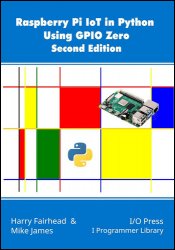 Название: Raspberry Pi IoT In Python Using GPIO Zero, 2nd Edition
Название: Raspberry Pi IoT In Python Using GPIO Zero, 2nd EditionАвтор: Harry Fairhead, Mike James
Издательство: IO Press
Год: 2024
Страниц: 260
Язык: английский
Формат: pdf (true)
Размер: 24.7 MB
The Raspberry Pi makes an ideal match for the Internet of Things. But to put it to good use in IoT you need two areas of expertise, electronics and programming and because of the way hardware and software engineering tend to occupy separate niches, you may need help with combining the two which is what this book sets out to do.
The Raspberry Pi family is an attractive set of devices to use to learn about physical computing or the IoT, but what language to use? You can do some IoT development in Scratch and C is powerful, but there is nothing much easier than Python – especially if you already know Python. Add to this the fact that there is a library, GPIO Zero, which makes working with GPIO lines and more sophisticated devices easy, and you can see that it is an even better choice.
What is new is that with the Pi 5 none of the existing libraries in other languages work as it is not compatible with previous Pis. This makes GPIO Zero the only easy way to write IoT programs that work on all versions of the Pi including the Pi 5. It is the recommended way to work with the Pi 5 and hence even more attractive to use with all Pis.
The only downside of using Python is that it can be too slow for some IoT applications and in this case you really do need C. However, Python is plenty fast enough for projects that involve actions on the tens of millisecond scale and, given how easy it is to perform sophisticated data processing in these situations, it often has the edge.
This book is about using and understanding the hardware and GPIO Zero. It not only shows you how to “follow the beaten track”, but how to create your own tracks. It isn’t a project book, but many of the devices described are part way to projects and all of the devices and techniques described can be used to create practical projects.
The emphasis here is on understanding how things work and using this knowledge to create and work with new devices and integrate them into GPIO Zero.
You can use any Python development system that you know, but we describe how to use Thonny and VS Code to do remote development. If you do decide to use this method the time to get started is slightly greater, but it has a lot of advantages. In particular, you can keep your Python program on a main machine and run them on any Pi you can SSH into. This makes it very easy to try your programs out on different models of the Pi.
Скачать Raspberry Pi IoT In Python Using GPIO Zero, 2nd Edition